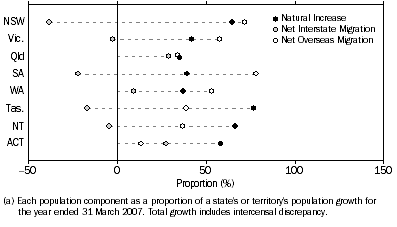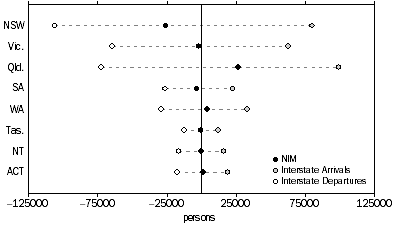MAIN FEATURES
AUSTRALIA: POPULATION AND GROWTH
The preliminary estimated resident population (ERP) of Australia at 31 March 2007 was 20,948,900 persons, an increase of 307,100 since 31 March 2006 and 96,600 persons since 31 December 2006. The increase for the year ended 31 March 2007 is the highest ever recorded for a 12 month period.
The annual population growth rate for the year ended 31 March 2007 at 1.49% was the highest annual growth rate since the year ended 30 June 1990.
PRELIMINARY DATA
Due to the collection and estimation methods applied to produce preliminary statistics from the components of population change, users should exercise caution when analysing and interpreting the most recent quarterly estimates.
COMPONENTS OF POPULATION CHANGE
Natural Increase
The growth of Australia's population has two components: natural increase (the number of births minus the number of deaths) and net overseas migration (net permanent and long-term movement).
Natural increase for the 12 months ended 31 March 2007 was 138,100 persons, an increase of 5.5% (or 7,200 persons) on the natural increase for the year ended 31 March 2006 (130,800 persons).
BIRTHS
The preliminary estimate for births (273,500) during the year ended 31 March 2007 was 3.8% higher than the figure for the year ended 31 March 2006 (263,500). Births in the year ended 31 March 2007 was the highest ever recorded for years ending 31 March. The total fertility rate (TFR) for the year ended 30 June 2006 was 1.804 which is the highest recorded since 1995.
Total fertility rates for the 2001-2006 intercensal period have been revised due to the revision of rebased ERP this quarter (see Table 13).
DEATHS
The preliminary estimate for deaths during the year ended 31 March 2007 (135,400) was the highest ever recorded for a year ending 31 March. The standardised death rate (SDR) for the year ended 30 June 2006 was 6.09 which is the lowest ever recorded.
Standardised death rates for the 2001-2006 intercensal period have been revised due to the revision of rebased ERP this quarter (see Table 14).
Net Overseas Migration
For the year ended 31 March 2007, Australia recorded a preliminary net overseas migration (NOM) estimate of 162,600 persons. The contribution made to population growth by NOM was eight percentage points higher than that of natural increase.
AN IMPROVED METHOD FOR CALCULATING NOM
The ABS has introduced an improved method for estimating NOM. This method has been used for September quarter 2006 onwards. Preliminary NOM estimates are based on international movement data for the reference quarter, adjusted by information derived from travellers with the same characteristics from the corresponding quarter two years earlier. Final NOM estimates for the four quarters of 2006-07 (scheduled for release in March 2009) will be based on the actual duration of stay in Australia and overseas of international travellers.
The time series using the previous method for calculating NOM finishes at June quarter 2006. Estimates from this past time series and the current time series are not comparable. For further information see Information Paper: Improved Methods for Estimating Net Overseas Migration (cat. no. 3107.0.55.003) released on 10 February 2006; Information Paper: Statistical Implications of Improved Methods for Estimating Net Overseas Migration, Australia 2007 (cat. no. 3107.0.55.005); and the Technical Note Measuring Net Overseas Migration, Method Used September Quarter 2001 to June Quarter 2006 in this publication.
STATES AND TERRITORIES: POPULATION AND GROWTH
The estimated resident populations for the states and territories at 31 March 2007 were as follows: New South Wales 6,876,000, Victoria 5,188,000, Queensland 4,162,000, South Australia 1,581,000, Western Australia 2,095,000, Tasmania 492,700, the Northern Territory 213,800, and the Australian Capital Territory 338,200.
All states and territories recorded positive population growth over the 12 months ended 31 March 2007. Queensland recorded the fastest growth rate (2.3%), followed by Western Australia (2.2%), the Northern Territory (2.0%), Victoria (1.5%), the Australian Capital Territory (1.5%), South Australia (1.0%), New South Wales (1.0%) and Tasmania (0.6%).
COMPONENTS OF POPULATION CHANGE
At the state and territory level, population growth has three components: natural increase, net overseas migration and net interstate migration.
Although all states and territories experienced positive population growth in the year ended 31 March 2007, the proportion that each of these components contributed to population growth varied between the states and territories.
Population Components, Proportion of total growth (a)
- Year ended 31 March 2007

Natural Increase
As illustrated in the graph above, natural increase was the major component of population growth in Tasmania at 76.9% (2,400 persons), the Northern Territory at 66.4% (2,700 persons), the Australian Capital Territory at 58.3% (2,800 persons) and Queensland at 35.1% (32,300 persons) for the year ended 31 March 2007.
BIRTHS
The number of births registered for the 12 months ended 31 March 2007 showed that the Northern Territory and Tasmania recorded annual decreases of 0.3% and 1.1% respectively. All other states and territories recorded an increase in birth registrations, with Western Australia recording the largest increase of 6.0%.
DEATHS
Deaths registered for the year ended 31 March 2007 showed the Northern Territory and Queensland both experienced annual decreases of 2.8% and 0.3% respectively. All other states and territories recorded an increase in death registrations, with the Australian Capital Territory recording the largest increase of 9.4%.
Net Overseas Migration
Net overseas migration for the year ended 31 March 2007, as illustrated in the previous graph, was the major component of population growth in South Australia at 78.5% (12,600 persons), New South Wales at 71.8% (48,800 persons), Victoria at 57.6% (42,900 persons) and Western Australia at 53.2% (23,700 persons). All other states and territories experienced positive NOM. New South Wales experienced the largest increase of 9,800 persons and Queensland experienced the largest decrease of 1,700 persons.
Net Interstate Migration
Estimates of quarterly interstate migration showed there were 344,900 persons moving interstate within Australia for the year ended 31 March 2007. Queensland and Western Australia recorded larger increases from net interstate migration when compared to the previous year ended 31 March. South Australia and New South Wales experienced a larger loss from net interstate migration whereas Victoria recorded a smaller loss. Over the same period, Tasmania and the Northern Territory changed from positive to negative net interstate migration, while the Australian Capital Territory changed from negative to positive net interstate migration.
INTERSTATE MIGRATION, Arrivals, Departures and Net
- States and territories
- Year ended 31 March 2007

For the year ended 31 March 2007, Queensland experienced the highest positive net interstate migration with a gain of 26,700 persons. Other states and territories to experience a positive net interstate migration were Western Australia (4,100 persons) and the Australian Capital Territory (1,300). Negative net interstate migration was experienced by New South Wales (-26,000 persons), South Australia (-3,500 persons), Victoria (-1,800 persons), Tasmania (-520 persons) and the Northern Territory (-180 persons).
 Print Page
Print Page
 Print All
Print All